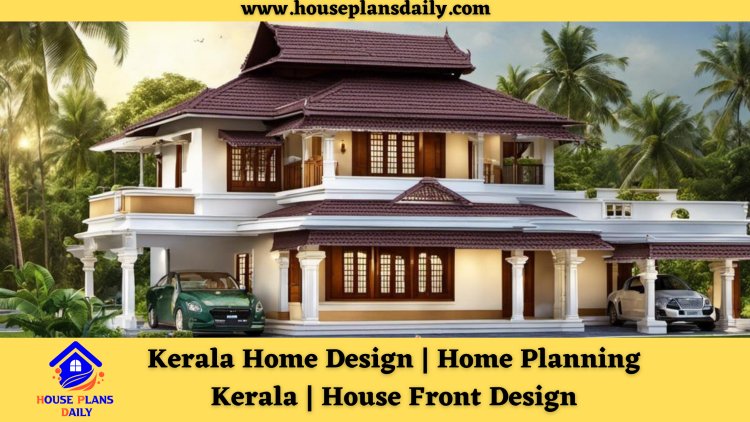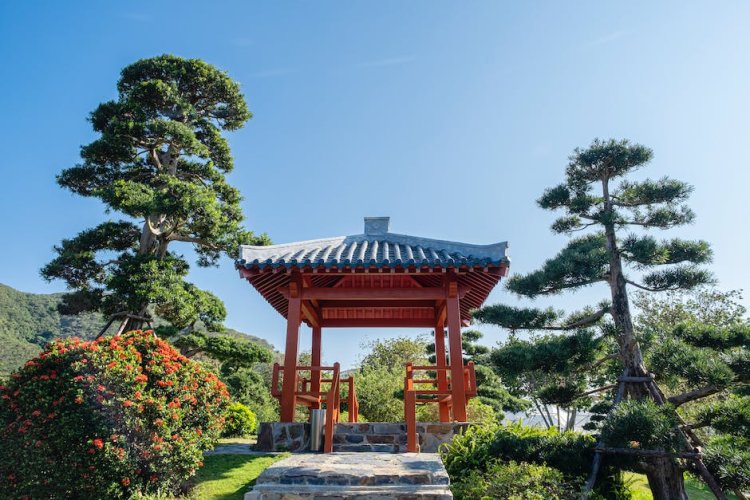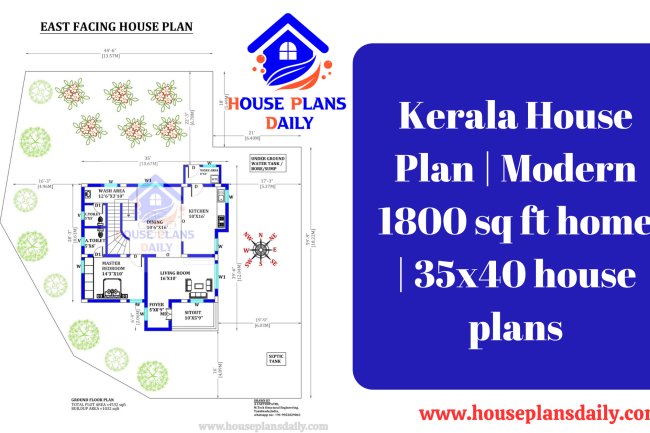Kerala Home Design | Home Planning Kerala | House Front Design
As the saying goes, "Home is where the heart is" and for many, their heart is deeply rooted in their homeland. The state of Kerala, along the Southwestern coast of India, is renowned not only for its rich cultural heritage and picturesque landscapes but also for its distinct architectural designs.
Kerala Home Design | Home Planning Kerala | House Front Design
As the saying goes, "Home is where the heart is" and for many, their heart is deeply rooted in their homeland. The state of Kerala, along the Southwestern coast of India, is renowned not only for its rich cultural heritage and picturesque landscapes but also for its distinct architectural designs. These unique traditional Kerala homes, also known as 'Nalukettu', are designed in harmony with nature and greatly influenced by the local geography, history, and climate. This discourse will travel through the fascinating journey of Kerala architecture from its ancestral roots to its graceful adaptation into modern home design, giving you a deep understanding of their integral elements and design principles.
Roots of Kerala Home Architecture
Origins of Kerala Home Architecture
The architectural style of Kerala homes has its roots in the rich history and tradition of the region. The design principles of these homes were first outlined in the architectural scriptures of Manushyalaya-Chandrika, Tantrasamuchaya, and Vasthuvidya, written between the 15th-18th centuries. The depictions in these texts, along with the influence from the Dravidian and colonial styles, formed the basis for the design of Kerala homes.
Influence of Kerala Climate on Home Design
The hot and wet tropical climate of Kerala had a profound impact on the architecture of the region, necessitating weather-resilient designs. The most notable feature of traditional Kerala homes is the sloping roof. Made of clay or laterite tiles, the steep slope of the roof ensured speedy drainage of heavy rainfall while the overhanging eaves offered an additional layer of protection against rain and harsh sunlight.
Geographical Influence on Kerala Home Design
Kerala's geographical features, rich with water bodies and lush greenery, significantly influenced the home design. The locally available resources like timber from the extensive forests and laterite, a type of soil rich in iron and aluminium, were primary materials used in constructing homes. The architecture evolved to integrate these naturally sourced materials, resulting in homes that were in tune with their surroundings.
Culture and Tradition of Kerala in Home Design
The socio-cultural aspect also played a key role in the design of traditional Kerala homes. The concept of Nadumuttam, or central courtyards, is a distinctive feature of these houses. The Nadumuttam is a traditional open space within the house around which the whole structure is built. It enhanced the circulation of natural light and air into the living spaces, keeping them bright, fresh, and cool. This layout also reflected the joint-family system prevalent in the region, enabling interaction and shared living among family members.
Kerala Home Design and Spirituality
Spiritual beliefs and rituals were often interwoven into the design elements of Kerala homes. Traditional homes often included a Koothambalam, or home stage, a spiritual space used for ritualistic performances and prayer. Other spiritually significant elements in the design were Pooja rooms or dedicated prayer spaces, the orientation of the house plan, and the placement of doors and windows.
Kerala Home Design: A Blend of Tradition and Modernity
Modern Kerala home designs skillfully marry the charming elements of traditional architecture with contemporary design trends. Employing evolved methods and materials, today's designers strive to uphold the essence of traditional styles within these new-age structures, creating fusion designs that are as aesthetically pleasing as they are functional. Whether it's the integration of the Nadumuttam style floor plan into modern flat designs or the incorporation of the iconic sloping roof into city dwellings, current Kerala home designs showcase a successful harmony of tradition and modernity.
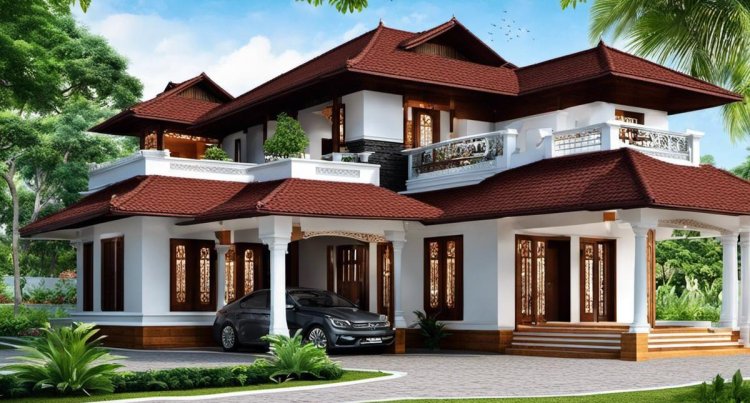
Key Elements of Kerala Home Design
Defining Features of Kerala Home Design
Known for a unique style that embodies Kerala's rich cultural and traditional heritage, Kerala home designs are famous worldwide. The defining features of these homes include sloping tile roofs, padippura or entrance gates, and the traditional poomukham or front verandas. These elements grant Kerala homes a certain sophisticated elegance while also serving practical purposes, setting them apart from other architectural styles.
Sloping Tile Roofs
Sloping tile roofs are a crucial characteristic of Kerala home designs. They are typically steep and pointy, designed in such a way to deal with the heavy rainfall in the state. These roofs effectively facilitate water drainage, protecting the house from potential water-related damage. Sloping roofs also provide a substantial flow of air, thereby maintaining a cooler temperature within the house. The tiles used on the roofs are usually baked clay products or sometimes even wooden shingles, adding a rustic charm to the overall look of the house.
Padippura - The Entry Gates
Padippura, also known as the entry gate, is another key element in Kerala home design. These entry gates are separate structures installed at the entrance of the compound. Traditionally, padippuras were used to signify one's social status. The more ornate the padippura, the higher the status of the family living in the house. Today, these entry gates serve more as a decorative element that enhances the exterior aesthetics of the home, welcoming visitors with a grand entry.
Poomukham - Front Veranda
Poomukham, translated as the front veranda, plays a dual role – it adds to the aesthetics and acts as a functional space in Kerala style homes. The poomukham is usually an extended space in front of the main door, generally supported by pillars. This space serves multiple purposes: it acts as a place for relaxation, as well as to welcome and entertain guests. The architectural detailing in the poomukham often reflects the art and traditional craftsmanship of Kerala, featuring ornate woodwork, intricate carvings, and classical motifs.
All of these elements - sloping tile roofs, ornate padippura, and functional poomukham - work collectively in Kerala homes design, presenting an excellent mix of aesthetics and utility that truly reflects the essence of Kerala's architectural tradition.
Material Usage in Kerala Home Design
The materials used in Kerala home designs also add to their distinctive style. Most traditional Kerala homes feature extensive use of natural materials like wood and laterite stones. The use of such materials not only contributes to the overall visual appeal of the house but also ensures a cooler environment inside the house. The interiors, with beautiful woodwork, exude a certain warmth and earthiness that is inherently comforting.
The unique allure of Kerala home designs stems from the distinct elements, materials, and design principles characteristic of this style. Each feature of these designs, be it the practical nature of the sloping tile roofs, the grandeur of the padippura, or the functional aspect of the poomukham, contributes to their inherent 'Keralite' flavor, all of which reflect the rich culture and tradition of Kerala.
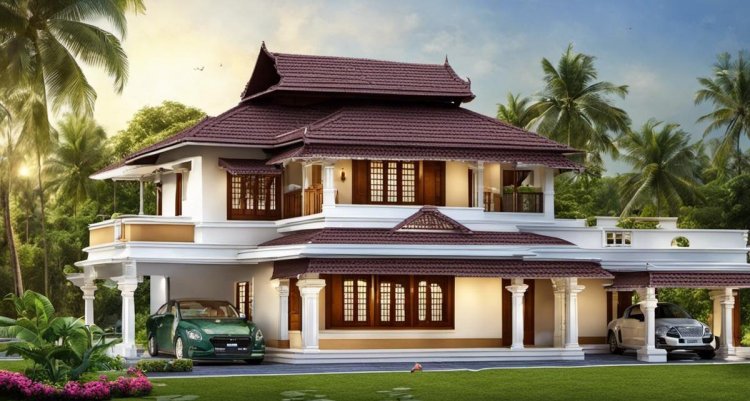
Modernizing Traditional Kerala Designs
Modern Interpretations of Traditional Kerala Design Concepts
Traditional Kerala homes are celebrated for their distinctive aesthetic features, such as the sloping roofs, elegant pillars, open courtyards, and meticulous woodwork. These elements work seamlessly with Kerala's tropical climate - the specially designed roofs aid in rainwater runoff, while courtyards promote natural lighting and ventilation. With the evolution of time, these classic designs are undergoing transformation, integrating modern materials, cutting-edge technologies, and contemporary design trends. The primary objective of this modernization process is to preserve the inherent charm of Kerala homes, while enhancing their practicality, functionality, and aesthetic appeal.
Incorporating Modern Materials and Technologies
One significant aspect of modernizing traditional Kerala designs is the use of contemporary materials and technologies. Traditional homes are typically built with local materials like teak, rosewood, or laterite stone. In modern Kerala homes, these materials are often combined with or replaced by more contemporary materials like reinforced cement concrete, glass, steel, or ceramic tiles.
For instance, roofs made of terracotta tiles, a traditional hallmark of Kerala architecture, are sometimes replaced with metal or concrete roofs in modern designs. However, sloping roofs are still maintained to keep up with the traditional design, and to ensure effective rainwater runoff.
Modern technologies are also used to enhance the convenience and functionality of these homes. Energy-efficient features, smart home systems, and green building concepts are increasingly incorporated into the designs. These could include solar panels, rainwater harvesting systems, and advanced thermal insulation.
Blending Design Trends
Apart from using modern materials and technologies, another key aspect of modernizing traditional Kerala homes is blending traditional and contemporary design aesthetics. This is often achieved by retaining key elements of traditional design and giving them a modern twist.
For example, courtyards, which have been an integral part of traditional Kerala homes, are reimagined in modern designs. These may be turned into glass-enclosed spaces or combined with modern landscaping elements. Likewise, ornate woodwork, which is significant in traditional Kerala architecture, may be simplified in modern designs, or blended with minimalistic decor elements.
Real-Life Examples of Modern Kerala Homes
An excellent example of a modernized traditional Kerala home is the Nalukettu house in Kozhikode by De Earth Architects. The home features a blend of traditional Kerala design and modern minimalism. It includes a courtyard that not only pays homage to traditional Kerala design but also introduces elements of modern design such as expansive glass walls to integrate indoor and outdoor spaces.
Similarly, the Cherai Beach House by LIJO.RENY.architects exemplifies modern aesthetics in a traditional context. While this home maintains the vernacular 'Nadumuttam' or central courtyard, it introduces modern elements such as concrete finish, glass walls, and sleek interiors, creating a harmonious blend of the old and new.
Modern Kerala homes beautifully combine traditional and contemporary design elements. This unique fusion is a tribute to Kerala's rich cultural heritage and the increasing influence of modern architectural trends.
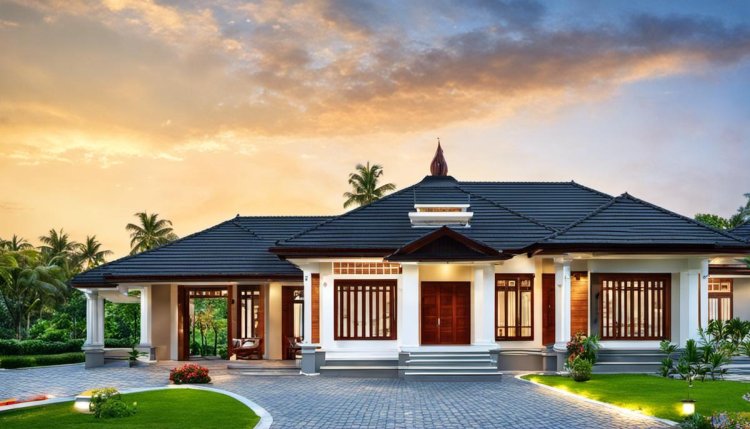
Designing Your Own Kerala Home
Diving Deeper into Kerala Home Design
This architecture style, known as Kerala home design, boasts a strong connection to its traditional roots, reflecting its regional architecture in a form that is both visually appealing and eco-friendly. Adopting the principles of thachu shastra, the science of carpentry, and the traditional Vastu, these homes exhibit architectural staples such as the Nalukettu - the old Tharavadu’s traditional dwelling with a single courtyard at the house center. Furthermore, they often showcase the Nadumuttom—an open central courtyard that serves as the hub of household activities—and Charupadi—a traditional seating arrangement using wooden bench-style seating along the veranda.
Collaborating with Architects
When you are envisioning your Kerala style home, consider collaborating with an architect experienced in this design scheme. They should have an understanding of the rich cultural, architectural history of Kerala homes, as well as modern techniques. Bring in references and samples of Kerala homes you like, as visual aids can be essential in conveying your ideas. Ensure you communicate your requirements and desires effectively for every section of the house – the space utilization, terrace design, the verandah, the ceiling, and so on.
Sourcing Materials
Kerala homes are built using eco-friendly materials. The exterior walls are generally made of laterite stone or brick. Use of natural materials will not only add to the charm and authenticity of the home design but will also create a cooling effect inside the house. For traditional wooden carvings, work with local artisans. Kerala houses are renowned for their wooden works and warm colours. The roofs are usually sloped and covered with old-fashioned clay tiles. These clay tiles, not only provide an aesthetic appeal but are also excellent for maintaining a cool indoor climate.
Incorporating Modern Utilities
When designing and constructing a Kerala style home, the trick to maintaining the traditional charm without sacrificing modern convenience is integration and balance. Install solar panels on the roof to merge sustainability with tradition. Consider incorporating an open floor plan for shared living spaces to bring a feeling of modern spaciousness. Integrate appliances into the design without obscuring the traditional elements –hide the modern kitchen appliances behind custom cabinetry designed to resemble traditional woodwork.
Interior Design Tips
Preserve the traditional charm with subtle cream or brown coloured walls and reclaimed or aged wood furniture. Consider using traditional Indian fabrics with bold colours and patterns for upholstery, drapes, and cushions to add an exotic touch. Terracotta tiles, wooden flooring or a combination of both could be used for the floors. It is crucial to maintain adequate natural lighting. Traditional Kerala homes have a central courtyard which promotes natural light. Make sure to integrate this element into your home's design to uphold the allure and aesthetic of Kerala architecture. Lighting should be kept soft and warm to promote a cozy and inviting atmosphere.
The final factor to think about when designing a Kerala home is keeping the design eco-friendly. This should encompass everything from the use of natural materials in construction, renewable energy sources, natural light and air circulation, and water conservation. Once you've mastered these elements, you'll be able to enjoy your very own slice of the Kerala lifestyle, no matter where you are in the world. Remember, creating a Kerala home is as much about embracing a lifestyle as it is about designing a living space.
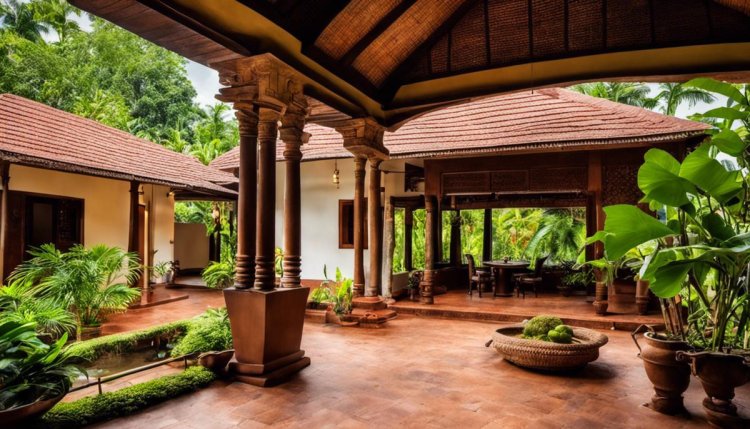
Indeed, the allure of Kerala architecture lies in the perfect blend of simplicity, beauty, and practicality. The journey we have embarked on unravels the evolution of these iconic abodes from their origins, their significant elements, and the fusion of traditional Kerala charm with modern aesthetics. As you envision your own Kerala home, remember to keep the essence of this architectural style intact while innovating with the modern. Our ancestors built with wisdom, understanding the land and climate, incorporating sustainability in their designs. Let our homes not just be our dwelling places but also a testimony of our respect for our roots and the legacy we want to leave behind for the future.
